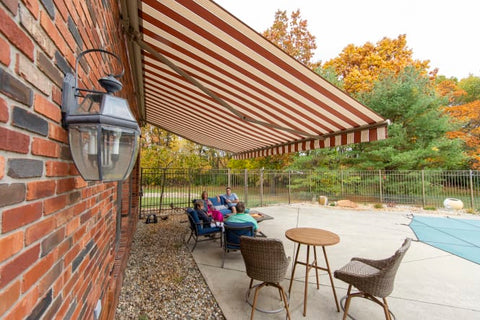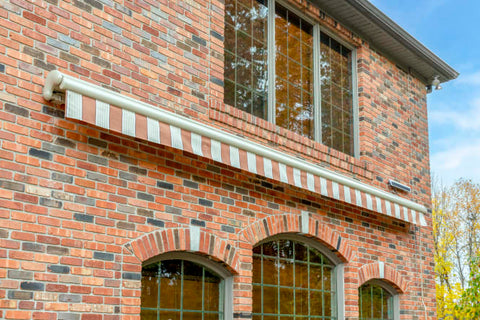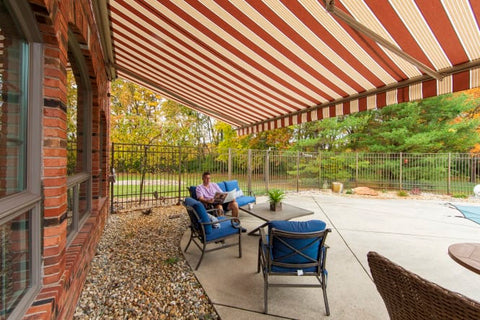Next
Are you dreaming of creating a cozy outdoor oasis right at your doorstep? An awning can transform your patio, deck or balcony into a shaded retreat, perfect for sipping morning coffee, hosting gatherings or simply enjoying the fresh air. If you're considering installing an awning, you're in for a treat! In this comprehensive guide, we'll explore the perks of awning installation, the factors to weigh, how to pick the perfect awning style for your home and expert advice to navigate the installation process, ensuring you're well-prepared for this exciting home improvement project.
Why Opt for a Residential Awning?
Introducing an awning to your home yields numerous advantages. From offering shelter from the sun and rain to enhancing energy efficiency and extending your outdoor living space, an awning for a house can significantly boost your home's comfort and functionality.
An awning can expand your usable living space. Whether you envision an outdoor dining area, a comfortable reading corner or a tranquil spot to enjoy your morning coffee, an awning can transform your outdoor space into a functional, appealing extension of your home.
One of the primary benefits is the barrier it provides against harsh weather. Whether you want to relish your outdoor space during scorching summer days or seek a sheltered spot during sudden rain showers, an awning is the perfect ally. It provides a shaded haven, shielding you from harmful UV rays and keeping you dry during unexpected rainfall.
Furthermore, installing an awning can enhance energy efficiency in your home. By installing an awning over windows and doors that receive direct sunlight, you can prevent excessive heat from entering your home. This reduces your reliance on air conditioning, lowers energy bills and promotes a sustainable lifestyle.

Types of Home Awnings
Awnings are a fantastic addition to homes, providing shade, protection and enhancing outdoor living spaces. Let's explore some common types of awnings and their features:
1. Retractable awnings
Retractable awnings are versatile and practical. They effectively block sunlight during hot summer days, keeping outdoor areas and rooms inside your home cooler. When winter arrives, you can easily retract them to allow sunlight into your home. These awnings come equipped with motors and remote controls, making extending and retracting a breeze.
2. Patio awnings
Patio awnings are generally wall-mounted and provide constant shade on porches or in backyards. By fixing them to the wall, you create a reliable shaded area for outdoor seating, dining or relaxation.
3. Conservatory awnings
Conservatory awnings enhance existing roof structures. They elevate the aesthetics of your conservatory or sunroom and offer protection from sun rays and harsh weather.
4. Vertical awnings
Vertical awnings are a sophisticated version of regular window blinds. They are retractable and use waterproof fabric for protection. Their scheduled operation feature sets them apart — you can program them to open and close at specific hours throughout the day. These awnings are perfect for windows, balconies and other outdoor spaces.
Remember to consider factors like material durability, maintenance and your specific needs when choosing an awning. Whether you opt for retractable, patio, conservatory or vertical awnings, they'll enhance your home's comfort and style!

Selecting the Perfect Awning Material
Choosing the right material for your awning is a crucial consideration that impacts its durability, maintenance needs and aesthetic appeal. Here's what you should consider:
1. Durability
Materials like aluminum offer long-lasting weather resistance, while fabric awnings give a softer look but require more upkeep.
2. Maintenance requirements
Aluminum awnings are virtually maintenance-free, while fabric awnings need regular cleaning and occasional resealing.
3. Aesthetic appeal
Your awning should enhance your home's style. Aluminum is versatile, while fabric offers more customization options.
Key Considerations for Home Awning Installation
Before you embark on your awning installation journey, it's crucial to consider several factors to ensure the awning style you choose aligns with your needs and preferences. Here are some important considerations for installing a home awning:
1. Evaluating available space
Assessing your outdoor area is a crucial step before installing a home awning. Consider the dimensions of your patio or backyard to determine the suitable size and style of the awning. It's essential that the awning fits well and enhances your home's overall aesthetic. Also, think about how you plan to use the awning. Whether you want to host outdoor parties or relax in the shade, you'll need to consider potential obstacles, the direction of the sun and wind patterns for optimal placement.
2. Understanding the local climate
Your local climate can significantly influence your awning choice. Living in an area with severe weather conditions might require a more durable, weather-resistant awning. An awning that provides ample shade and UV protection might be ideal in hot climates.
3. Setting a budget
Your budget is another vital factor. Determine how much you are willing to invest in an awning, including installation costs. Awnings vary in price depending on size, material and additional features. It is wise to set a budget and explore options that fit your financial limits.
By taking these considerations into account, you can ensure a successful retractable awning installation that aligns with your needs and preferences.

Can I Install an Awning Myself?
The short answer is: Yes, you can! Installing an awning is a feasible DIY project for homeowners with intermediate-level skills. However, safety first! If you're comfortable working on a ladder and altering your home’s exterior, you're all set to move forward. Here are several factors to consider:
1. Handy skills
If you have experience with basic tools and home improvement projects, you'll be better equipped for the installation.
2. Safety gear
Ensure you have appropriate safety gear, especially when working at heights.
3. Tools
You'll likely need a ladder, power drill, drill bits and masonry bits. You may also need silicone caulk and aluminum tubing for specific installations.
4. Recruit a friend
Even if you're a DIY enthusiast, awnings are easier to handle with an extra pair of hands. Enlist a friend or two — and repay them with a shady retreat under the awning after installation!
5. Mounting surface
Whether it's siding, brick or stucco, ensure your mounting surface can support the awning's weight. Some walls or structures may require additional reinforcement.
6. Awning weight
Before you hoist that awning, consider its weight and seek necessary help to lift it into the proper location.
While DIY installation is feasible, weighing the pros and cons is essential. If you're confident in your skills and have the necessary tools, go ahead. Otherwise, consider seeking professional assistance to avoid potential issues.
If you're considering a professional installation, start by choosing a reputable company with a track record of positive customer reviews. An experienced awning installation company will guide you through the process, from selecting the right awning to ensuring proper installation.
Accurate measurements are crucial for a successful awning installation. A professional team will take precise measurements and use correct installation techniques to ensure a secure and stable awning.

Elevate Your Home with the Furrion Lumina™ Awning
Transform your outdoor living space with the Furrion Lumina solar-powered retractable awning, the ultimate blend of style and functionality for your home. This innovative, motorized awning is designed with eco-friendly solar power, a unique feature exclusive to Furrion. It eliminates the need for unsightly cords or professional installation, allowing you to enjoy more time relaxing outdoors with its low-maintenance, high-convenience design.
The Furrion Lumina isn't just an awning; it's a complete shading solution built to last. Its sleek, semi-cassette housing looks modern and protects the fabric when not in use. The robust lateral arm design, enhanced with dual-coated stainless steel cables, ensures long-lasting durability and reliable performance. The awning is crafted from premium Sunbrella woven acrylic fabric, combining sophisticated aesthetics with superior sun protection. The quiet solar motor allows for effortless extension and retraction, and the adjustable pitch (0-45 degrees) lets you customize your shading angle. Additionally, the built-in wind sensor provides automatic retraction during strong winds, giving you a sense of security and peace of mind.
Experience the ease of smart living by integrating the Furrion Lumina with voice assistants like Amazon Alexa or Google Assistant for seamless control. Stay ahead of the weather with the AwnCommand™ app, which alerts you to potential inclement conditions. The awning's versatile installation options allow it to be mounted on walls, roofs, or the underside of eaves and overhangs, and it is compatible with a variety of materials such as siding, wood, vinyl, aluminum, masonry, and brick.
Make your outdoor space truly yours with the Furrion Lumina. Customize your awning to fit your space perfectly, with available widths from 12 ft. to 20 ft. and projections up to 12 ft. Choose from an array of designer colors in premium Sunbrella woven acrylic fabric and multiple powder-coated frame options to match your unique outdoor decor. With the Furrion Lumina, your outdoor area will become a stylish and functional extension of your home, tailored to your personal taste.
How to Install a Furrion Lumina Awning
Frequently Asked Questions About Home Awning Installation
Q: What do you need to install an awning?
A: To install a home awning, you'll need intermediate-level handy skills, proper safety gear and various tools, such as a ladder, power drill, drill bits and masonry bits. You may also need silicone caulk and aluminum tubing for specific installations.
Q: Can I install an awning on my own?
A: Yes, but follow safety guidelines and consider professional help if needed.
Q: How do I choose the right size awning?
A: Measure your outdoor space and visualize the coverage area. Consider potential obstacles, the direction of the sun and wind patterns for optimal placement.
Q: Why choose a retractable awning?
A: Retractable awnings offer flexibility, style and protection. These awnings come equipped with motors and remote controls, making extending and retracting a breeze.
Posted On
Apr 11, 2024


